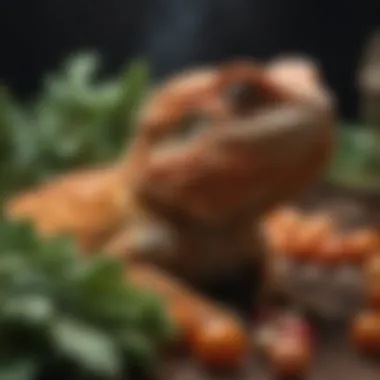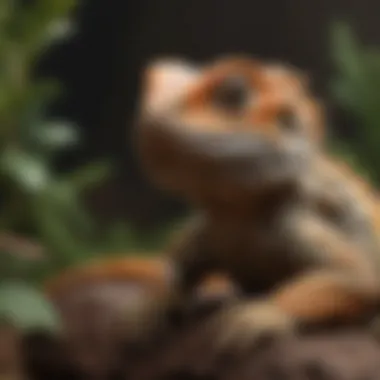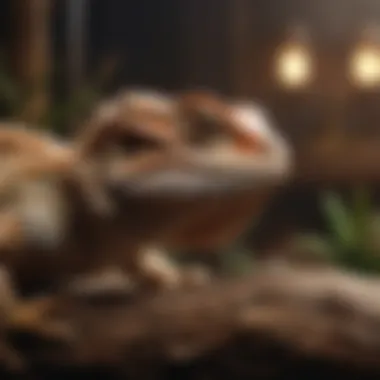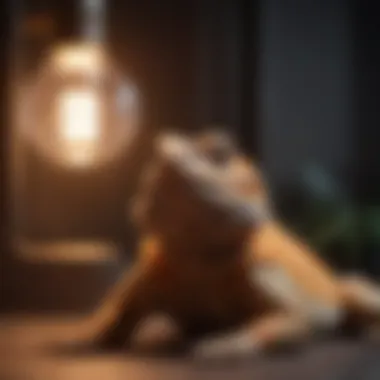Comprehensive Guide to Daily Bearded Dragon Feeding


Intro
Feeding a bearded dragon daily involves understanding their unique nutritional requirements. This reptile, native to Australia, has specific dietary needs that vary throughout its life. From hatchlings to adults, bearded dragons require diverse diets to thrive. Their health hinges on the balance of proteins, vegetables, and occasional fruits.
This guide aims to equip you with the necessary knowledge to provide your bearded dragon with a well-rounded diet. It will cover essential insights about food types suitable for different life stages, diet diversity, feeding tips, common misconceptions, and the impact of habitat conditions on feeding.
As you journey through this article, you will gain a clear understanding of how to enhance your bearded dragon’s health through proper nutrition.
Understanding Bearded Dragon Nutrition
Understanding the nutritional needs of bearded dragons is crucial for their overall health and well-being. These reptiles require a careful balance of nutrients to thrive, and bearded dragon owners must be knowledgeable about these needs. This knowledge forms the basis of providing a proper diet, which is essential for digestion, energy, growth, and maintenance of their bodily functions. An informed approach to feeding ensures that bearded dragons receive not just enough food, but the right kind of food suitable for their specific life stages.
Importance of a Balanced Diet
A balanced diet is at the core of bearded dragon nutrition. It directly impacts their growth rate, reproductive health, and resistance to disease. Inadequate or imbalanced nutrition can result in serious health issues, including metabolic bone disease, which is a common affliction in reptiles due to calcium deficiency. The right combination of insects, vegetables, and supplements provides the necessary building blocks for strong bones, a healthy immune system, and proper organ function.
In addition to physical health, a balanced diet promotes behavioral wellness. Bearded dragons that receive proper nutrition exhibit significantly improved energy levels and temperament. Consequently, understanding how to balance their diet can foster a happier, more active pet.
Nutritional Requirements
Nutritional requirements of bearded dragons encompass a range of essential elements, specifically vitamins and minerals, proteins, and carbohydrates. Each component plays a unique role in the health of these reptiles, ensuring they can flourish in captivity.
Vitamins and Minerals
Vitamins and minerals are vital for metabolic function and growth in bearded dragons. These nutrients ensure that bodily processes operate at optimal levels, supporting their immune system and general vitality. A diverse selection of fruits and vegetables can provide essential vitamins such as A, D3, and calcium. These nutrients are crucial for strong bone development and overall vitality.
The key characteristic of vitamins and minerals is their role in preventing specific deficiencies that could lead to health problems. For example, calcium is especially beneficial for maintaining bone density. Unlike some nutrients, which can be synthesized by the body, most vitamins and minerals must be provided through diet, making them especially important in bearded dragon nutrition.
However, it is essential to be cautious with supplementing these nutrients, as over-supplementation can also lead to toxicity issues in reptiles.
Proteins
Proteins serve as a fundamental building block for tissue growth and repair. They are also crucial for the production of enzymes and hormones that regulate bodily functions. Insects, such as crickets and mealworms, are rich in protein and should form a significant part of a bearded dragon's diet, particularly in their juvenile stage when significant growth occurs.
The prominent feature of proteins is their ability to support growth and development, particularly during early life stages. It is a popular choice in the diet of juvenile bearded dragons, as they require higher protein levels compared to adults. However, an excess of protein can lead to obesity and related health issues, making it necessary to balance their intake adequately.
Carbohydrates
Carbohydrates provide a source of energy for bearded dragons. While they are not as crucial as proteins, they still play an important role in their diet. Many plant-based foods, such as various vegetables, contain carbohydrates that contribute to the metabolic energy needed for day-to-day activities.
The key characteristic of carbohydrates is their ability to quickly supply energy, which is beneficial for bearded dragons who are active and engage in various activities. Nevertheless, it's also important to note that while carbohydrates are valuable, too high a proportion of them can lead to a range of health issues. A proper balance with proteins and fats is essential for the long-term health of these reptiles.
Daily Feeding Guidelines
Daily feeding guidelines are crucial for ensuring the long-term health and well-being of bearded dragons. Proper nutrition contributes significantly to their growth, energy levels, and immune support. Understanding the specific dietary needs at various life stages allows owners to tailor their feeding strategies effectively. This section aims to elucidate why adhering to these guidelines is essential, offering clarity and actionable insights for owners.
Age-Specific Diets
Juvenile Bearded Dragons
Juvenile bearded dragons, typically under 6 months old, have high metabolic rates and needs. They often require a diet rich in protein to support their rapid growth. This group thrives on a higher proportion of insects, such as crickets and roaches, compared to adults. The key characteristic of juveniles is their voracious appetite, which makes feeding a more frequent task. Properly addressing their nutritional needs is beneficial, as their development relies heavily on these early dietary choices. However, one challenge is the need to manage the risk of obesity carefully, as overfeeding can lead to health issues later in life.


Adult Bearded Dragons
Adults, usually over 18 months old, have different dietary requirements. Their diet balances plant-based materials and insects. While they still consume protein, it is vital to reduce the proportion of insects and increase leafy greens. Adult bearded dragons are less active than juveniles and have different nutritional needs to prevent health problems such as obesity or metabolic bone disease. The unique feature of adults is their adaptability; they can subsist on a well-planned variety of foods. This variety can be advantageous, but owners must remain vigilant to prevent nutritional deficiencies related to poor diet choices.
Seniors and Special Cases
Seniors and special cases, including those recovering from health issues, often have unique dietary needs. As bearded dragons age, they may become less active, affecting their metabolism and caloric needs. The key characteristic here is the necessity for a more tailored diet. This group benefits from softer, easier-to-digest foods, with an increased focus on hydration and nutrient absorption. Owners should offer high-quality greens, with occasional protein, to maintain health. On the downside, feeding a senior bearded dragon can be challenging as their preferences might shift, and it is essential to monitor their weight regularly to avoid any health complications.
Frequency of Feeding
Feeding frequency varies by age and lifestyle. Juveniles typically require feeding several times a day, while adults can be fed every other day. Understanding the right frequency prevents overfeeding and underfeeding, leading to optimal growth and health. Adjusting the feeding schedule to suit the dragon's activity levels is crucial; for example, a more active dragon may need more frequent feeds initially. Proper frequency, alongside appropriate diets, positions owners to support the best possible health outcomes for their bearded dragons.
Types of Food to Offer Daily
Feeding your bearded dragon requires careful consideration of the types of food offered daily. A varied diet is critical for their health and development. This section will outline essential food categories, focusing on the unique benefits of both insects and vegetables. Each type has its role in providing nutrients that are vital for overall well-being.
Insects
Insects are a primary source of protein for bearded dragons. They are energy-dense and provide essential nutrients that bearded dragons need for growth and activity. Offering a variety of insects can contribute different minerals and vitamins to their diet.
Crickets
Crickets stand out as one of the most popular food choices among reptile owners. They are easy to digest and packed with protein. One key characteristic is their availability; crickets are readily found in pet stores and online. They provide various vitamins, which are essential for growth.
However, it is important to feed crickets that have been gut-loaded for optimal nutrition. Gut-loading involves feeding them a nutrient-rich diet before offering them to your bearded dragon. Without this, crickets can be low in nutritional value.
Roaches
Roaches, particularly Dubia roaches, are another excellent insect option. They are high in protein and low in fat, making them an efficient food source. One significant advantage of roaches is their longer lifespan compared to crickets. This characteristic allows owners to maintain a more consistent food source without frequent repurchases.
However, some people may find roaches less appealing due to their appearance. Keeping them requires some additional care, such as proper housing and temperature control.
Worms
Worms can provide a different texture and taste for your bearded dragon. Options like mealworms or waxworms are often favored by many reptiles for their high fat content. This can be beneficial during certain life stages, particularly for juvenile dragons needing to gain weight.
One downside, however, is that some worms can contribute to obesity if fed in excess. Hence, they should be offered in moderation, ensuring nutrients are balanced with other foods in their diet.
Vegetables and Greens
Vegetables and greens are crucial for a balanced diet. They provide fiber, vitamins, and minerals that support digestion and overall health. Leafy greens and other veggies can help maintain hydration and also promote good eye and skin health.
Leafy Greens
Leafy greens, such as collard greens and dandelion greens, should be staples in any bearded dragon's diet. They are rich in calcium, which is essential for bone development. This characteristic makes them a preferred choice for many bearded dragon owners.
One primary advantage of leafy greens is their high fiber content, which aids in digestion. However, not all greens are beneficial. For example, iceberg lettuce offers very little nutritional value and can lead to poor health if fed regularly.
Squash and Bell Peppers
Squash and bell peppers are vibrant additions to the diet. They are packed with vitamins A and C, both of which are important for immune function. Their texture can add variety to meals, making feeding more enjoyable for both the dragon and the owner.


One downside is that if these vegetables are not properly chopped, they can pose a choking hazard for young dragons. Ensuring the pieces are manageable is crucial when offering squash and bell peppers.
Fruits and Treats
Fruits can serve as a delightful treat but should not dominate the diet. Options like strawberries and blueberries provide natural sweetness and can be an enjoyable snack. They can also provide hydration, which is vital for bearded dragons.
However, fruits are high in sugar. This can lead to fat accumulation if overfed. Therefore, it is advisable to offer fruits in small amounts, ensuring that the primary focus remains on vegetables and proteins in their diet.
The diversity of food types is essential for maintaining a healthy bearded dragon. A varied diet helps avoid deficiencies and promotes long-term well-being.
Creating a Feeding Schedule
Creating a proper feeding schedule is critical for ensuring the health and happiness of your bearded dragon. These reptiles have distinct dietary and energy requirements at different life stages. A well-planned schedule helps prevent feeding mistakes and encourages a balanced nutrient intake. When you establish a consistent feeding pattern, your bearded dragon becomes accustomed to it, which promotes a healthier appetite and digestion.
Developing a Routine
A feeding routine aids in assessing how much your bearded dragon is eating on a daily basis. This can be particularly important for spotting potential health issues. Preparing and offering food at the same times each day allows you to monitor its behavior and appetite with greater accuracy.
When you develop a routine, consider starting with a consistent time for each meal. Aim for times that align with your pet's natural activity levels. For example, bearded dragons are often more active in the morning and early afternoons.
- Morning Feeding: Most reptiles, including bearded dragons, respond well to morning feeding. This is when they are naturally inclined to seek food.
- Evening Supplement: If you choose, an evening snack can be given but should be light. This keeps the digestive system engaged without overloading it.
Monitoring portion sizes is another key aspect of this routine. Calculate the ideal portion based on age and weight, and adjust as required over time.
Adjusting for Activity Levels
Activity levels can vary based on environmental factors, illness, or stress. When adjusting feeding frequency, it is crucial to observe your bearded dragon carefully. An inactive dragon may not require the same quantity of food as one that is active and energetic.
- Environmental Temperature: Be sure the habitat is set to optimal temperature ranges during feeding times. Cold temperatures can slow metabolism, leading to reduced food intake.
- Seasonal Changes: Understand that bearded dragons may eat less during the winter or periods of less activity. This means your feeding schedule should be flexible to accommodate such changes.
- Health Considerations: If your bearded dragon shows signs of lethargy or refuses to eat, consult a veterinarian. Adjust feeding accordingly, perhaps offering less frequent or smaller meals until the underlying issue is resolved.
"A well-structured feeding schedule not only supports healthy growth but also encourages positive behavior in bearded dragons."
Monitoring Health and Nutrition
Monitoring the health and nutrition of your bearded dragon is fundamental for ensuring its well-being. A proper diet not only supports growth and development but also enhances the immune system and overall vitality. Bearded dragons can experience several health issues due to dietary deficiencies or improper feeding practices. By keeping an eye on specific indicators, owners can proactively address any problems.
It is essential to recognize that a balanced diet is the bedrock of a healthy life for your bearded dragon. Regularly assess the diet to include a variety of appropriate foods that cater to all nutritional needs.
Signs of Nutritional Deficiency
Identifying signs of nutritional deficiency early can make a significant difference in the health of your bearded dragon. Some of the common symptoms include:
- Lethargy: A bearded dragon lacking energy may be suffering from inadequate nutrition.
- Weight Changes: Noticeable weight loss, or on the other hand, obesity can signal dietary issues.
- Impaired Growth: Baby dragons not reaching expected growth milestones might have nutritional gaps.
- Eye Issues: Swelling or a dull appearance in the eyes can indicate vitamin A deficiency.
- Mouth Rot: This condition may arise from a lack of essential nutrients, leading to sores or inflammation.
By being mindful of these symptoms, owners can adjust the feeding regimen accordingly. If any of the symptoms become apparent, an evaluation of current feeding practices is warranted. Regular observation helps maintain health and prevents potential illnesses before they become severe.
Consulting a Veterinarian
Consulting a veterinarian is crucial for any bearded dragon owner, especially if you suspect nutritional deficiency or observe abnormal behavior or physical symptoms. A vet familiar with reptiles can provide expert advice tailored to the specific needs of your dragon. They may suggest:
- Nutritional Supplements: In some cases, additional vitamins and minerals may be necessary to address deficiencies.
- Dietary Changes: A veterinarian can help craft a balanced diet based on the bearded dragon's age, size, and specific health needs.
- Lab Tests: If symptoms persist, lab tests may be needed to diagnose underlying issues accurately.


Routine check-ups ensure that your bearded dragon receives the best care possible. Regular monitoring not only helps in preventing deficiencies but also assists in maintaining an overall healthy lifestyle for your pet. Always be proactive and keep an open dialogue with your veterinarian to optimize your bearded dragon's health.
Common Feeding Mistakes to Avoid
Understanding the common feeding mistakes to avoid is essential for all bearded dragon owners. These mistakes can lead to serious health problems for your pet. Both overfeeding and neglecting variety are crucial issues that need your attention. Learning about these pitfalls helps ensure a healthier diet for your dragon, enabling better growth and longevity.
Overfeeding
Overfeeding is a common issue among owners. Bearded dragons can quickly gain excessive weight if they are given too much food. This can lead to obesity, which causes various health risks, including organ failure and heart disease.
- Recognizing Portion Sizes: When serving insects, remember that gut-loaded insects provide vital nutrients. A juvenile dragon may eat more frequently than an adult, so assess their needs based on life stage.
- Adult Diet Plans: Adults may require less food compared to juveniles. They are not as active and tend to have slower metabolism.
- Physical Signs: Observe your dragon’s body condition. An excessively plump dragon may need a reduced food intake.
To mitigate overfeeding, always measure portions carefully rather than free-feeding. Regular weigh-ins can help track weight changes.
"Monitoring intake is not just about avoiding obesity; it also aids in identifying other health issues early."
Neglecting Variety
Another significant mistake is neglecting variety in the diet. Bearded dragons have diverse nutritional needs that change as they grow. A diet lacking in variety can lead to deficiencies in essential vitamins and minerals.
- Including Different Food Groups: Your dragon's diet should be a balanced mix of insects, vegetables, and fruits. Leafy greens like collard and mustard greens should form a significant part of their daily meals.
- Insect Diversity: While crickets and mealworms are popular, integrating other protein sources such as roaches or hornworms ensures a broad nutrient intake. Variety also helps stimulate your dragon’s appetite.
- Seasonal Treats: Fruits should be offered in moderation and as occasional treats. Fruits can be exciting but should not dominate their diet.
By avoiding a monotonous feeding routine, you promote better overall health. Always aim for a colorful, varied plate that mimics their natural foraging behavior. Adapting their diet to include diversity addresses nutritional gaps and supports optimal health.
The Role of Habitat in Nutrition
Understanding the habitat of your bearded dragon is essential for ensuring optimal nutrition. The environment in which your reptile lives directly impacts its ability to digest food and absorb nutrients effectively. Proper habitat conditions include appropriate temperature, humidity, and space. These factors not only influence feeding behavior but also overall health and well-being.
Temperature and Digestive Health
Maintaining the right temperature in the enclosure is vital. Bearded dragons are ectothermic, meaning they rely on external heat sources to regulate their body temperature. Ideal temperatures typically range between 95 to 110 degrees Fahrenheit in the basking area and around 80 to 85 degrees Fahrenheit in the cooler sections.
When the temperature is too low, a bearded dragon’s metabolism can slow down. This sluggishness may lead to poor digestion and absorption of nutrients from food. Moreover, a cooler environment can increase the likelihood of food-related illnesses.
It is recommended to invest in quality thermometers to monitor the habitat's temperature accurately. Additionally, providing a proper basking spot enhances the bearded dragon's ability to digest food efficiently. A heat lamp or ceramic heat emitter can serve this purpose well.
Hydration Needs
Hydration is another critical aspect of habitat considerations. Bearded dragons require access to clean water daily. How hydrated your dragon is can significantly affect its health and digestion. Dehydrated bearded dragons may experience constipation or impactation, leading to serious health issues.
Water should be provided in a shallow dish, and misting the enclosure is helpful, especially prior to shedding. Monitor your bearded dragon for signs of dehydration, such as sunken eyes or dry skin. Ensuring it stays adequately hydrated helps maximize the digestive process and supports nutrient absorption.
Proper habitat not only aids in digestion but enhances your bearded dragon's overall quality of life. Keep the environment clean and regulated.
The End
In the journey of understanding bearded dragon care, the conclusion serves as a crucial touchpoint that encapsulates the essence of the preceding discussions. It reminds us of the core principles that govern bearded dragon nutrition and offers a consolidation of knowledge that enhances both the owner’s and the pet’s experience. Properly feeding your bearded dragon is not just about filling a bowl; it is about fostering a healthy and balanced lifestyle that can profoundly affect their longevity and well-being.
Recap of Key Points
Several influential factors have been highlighted throughout this guide:
- Balanced Diet: A combination of insects, vegetables, and occasional fruits provides the essential nutrients that bearded dragons need.
- Age-Specific Needs: Juveniles require more protein, while adults need a greater emphasis on greens and vegetables.
- Feeding Schedule: Regular feeding times and portion control prevent overeating and promote better digestion.
- Habitat Considerations: The environment, including temperature and hydration, plays a significant role in ensuring that food is processed efficiently and absorbed properly.
This summary underscores the necessity of attention to detail when caring for these reptiles. It serves as a foundation for responsible ownership.
Encouragement for Bearded Dragon Owners
As a bearded dragon owner, your commitment to understanding their needs directly impacts their quality of life. Embrace the responsibility of providing a varied and balanced diet. Don't hesitate to consult with a veterinarian about any uncertainties regarding nutrition. Remember, each dragon is unique, and what works for one may not be ideal for another.
> Effective care is an evolving journey. Connecting with others on platforms like Reddit or engaging in community discussions can offer further support and insights. Share experiences and learning with fellow bearded dragon lovers on Facebook, where you can find groups dedicated to this fascinating pet.
By being proactive in your approach, you will not only enhance your bearded dragon’s overall health but also cultivate a profound bond that enriches both your lives. With informed decisions, regular monitoring, and willingness to adapt, you can ensure your bearded dragon thrives.















